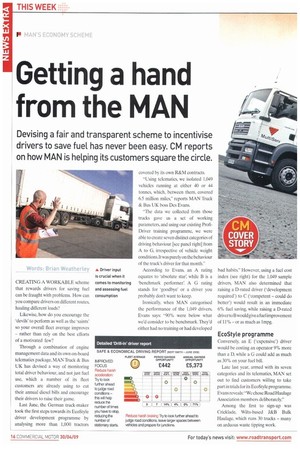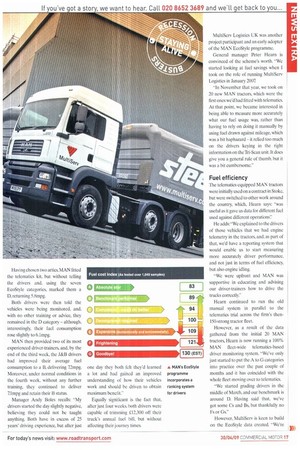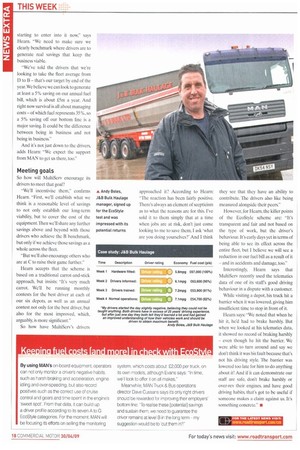Getting a hand from the MAN
Page 16

Page 17

Page 18

If you've noticed an error in this article please click here to report it so we can fix it.
Devising a fair and transparent scheme to incentivise drivers to save fuel has never been easy. CM reports on how MAN is helping its customers square the circle.
CREATING A WORKABLE scheme that rewards drivers for saving fuel can be fraught with problems. How can you compare drivers on different route', hauling different loads?
Likewise, how do you encourage the 'devils' to perform as well as the 'saints' so your overall fleet average improves — rather than rely on the best efforts of a motivated few?
Through a combination of engine management data and its own on-board telematics package, MAN Truck & Bus UK has devised a way of monitoring total driver behaviour, and not just fuel use, which a number of its fleet customers are already using to cut their annual diesel bills and encourage their drivers to raise their game.
Last June, the German truck-maker took the first steps towards its EcoStyle driver development programme by analysing more than 1,000 tractors covered by its own R&M contracts.
"Using telematics, we isolated 1,049 vehicles running at either 40 or 44 tonnes, which, between them, covered 6.5 million miles," reports MAN Truck & Bus UK boss Des Evans.
"The data we collected from those trucks gave us a set of working parameters. and using our existing ProfiDriver training programme, we were able to create seven distinct categories of driving behaviour [see panel right] from A to G, irrespective of vehicle weight conditions. It was purely on the behaviour of the truck's driver for that month."
According to Evans, an A rating equates to 'absolute star'. while B is a 'benchmark performer: A G rating stands for 'goodbye' or a driver you probably don't want to keep.
Ironically, when MAN categorised the performance of the 1,049 drivers. Evans says: "90% were below what we'd consider to be benchmark. They'd either had no training or had developed had habits." However, using a fuel cost index (see right) for the 1.049 sample drivers, MAN also determined that raising a D-rated driver ('development required') to C ('competent — could do better') would result in an immediate 6% fuel saving, while raising a D-ratcd driver to B would give a fuel improvement of 11% or as much as lmpg.
EcoStyle programme
Conversely, an E (expensive') driver would be costing an operator 9% more than a D. while a G could add as much as 30% on your fuel bill.
Late last year, armed with its seven categories and its telematies, MAN set out to find customers willing to take part in trials for its EcoStyle programme. Evans reveals: "We chose Road Haul age Association members deliberately."
Among the first to sign-up was Cricklade, Wilts-based J&B Bulk Haulage, which runs 30 trucks — many on arduous waste tipping work. Having chosen two artics, MAN fitted the telematics kit, but without telling the drivers and, using the seven EcoStyle categories, marked them a D, returning 5.8mpg.
Both drivers were then told the vehicles were being monitored, and, with no other training or advice, they remained in the D category — although, interestingly, their fuel consumption rose slightly to 6.1mpg.
MAN then provided two of its most experienced driver-trainers, and, by the end of the third week, the J&B drivers had improved their average fuel consumption to a B. delivering 72mpg. Moreover, under normal conditions in the fourth week, without any further training, they continued to deliver 7.1mpg and retain their B status.
Manager Andy Boles recalls: "My drivers started the day slightly negative, believing they could not be taught anything. Both have in excess of 25 years' driving experience, but after just one day they both felt they'd learned a lot and had gained an improved understanding of how their vehicles work and should be driven to obtain maximum benefit."
Equally significant is the fact that, after just four weeks, both drivers were capable of trimming 112,300 off their truck's annual fuel bill, but without affecting their journey times. MultiServ Logistics UK was another project participant and an early adopter of the MAN EcoStyle programme.
General manager Peter Hearn is convinced of the scheme's worth. "We started looking at fuel savings when I took on the role of running MultiServ Logistics in January 2007 -In November that year, we took on 20 new MAN tractors, which were the first ones we'd had fitted with telematics. At that point, we became interested in being able to measure more accurately what our fuel usage was, rather than having to rely on doing it manually by using fuel drawn against mileage, which was a bit haphazard it relied too much on the drivers keying in the right information on the Tri-Scan unit. It does give you a general rule of thumb, but it was a bit cumbersome."
Fuel efficiency
The telematics-equipped MAN tractors were initially used on a contract in Stoke, but were switched to other work around the country, which, Hearn says: "was useful as it gave us data for different fuel used against different operations': He adds:"We explained to the drivers of those vehicles that we had engine telemetry in the tractors, and, as part of that, we'd have a reporting system that would enable us to start measuring more accurately driver performance, and not just in terms of fuel efficiency, but also engine idling.
"We were upfront and MAN was supportive in educating and advising our driver-trainers how to drive the trucks correctly."
Hearn continued to run the old manual system in parallel to the telematics trial across the firm's then150-strong tractor fleet.
However, as a result of the data gathered from the initial 20 MAN tractors, Hearn is now running a 100% MAN fleet-wide telematics-based driver monitoring system. "We've only just started to put the A to G categories into practice over the past couple of months and it has coincided with the whole fleet moving over to telematics.
"We started grading drivers in the middle of March, and our benchmark is around D. Having said that, we've got some Cs and Bs, but thankfully no Fs or Gs."
However, MultiServ is keen to build on the EcoStyle data created. "We're starting to enter into it now," says Hearn. "We need to make sure we clearly benchmark where drivers are to generate real savings that keep the business viable.
"We've told the drivers that we're looking to take the fleet average from D to Bthat's our target by end of the year. We believe we can look to generate at least a 5% saving on our annual fuel bill, which is about f5m a year. And right now survival is all about managing costs of which fuel represents 35%, so a 5% saving off our bottom line is a major saving. It could be the difference between being in business and not being in business."
And it's not just down to the drivers, adds Hearn: "We expect the support from MAN to get us there, too."
Meeting goals
So how will MultiServ encourage its drivers to meet that goal?
"We'll incentivise them," confirms Hearn. "First, we'll establish what we think is a reasonable level of savings to not only establish our long-term viability, but to cover the cost of the equipment.Then we'll share any further savings above and beyond with those drivers who achieve the B benchmark, but only if we achieve those savings as a whole across the fleet.
"But we'll also encourage others who are at C to raise their game further."
Hearn accepts that the scheme is based on a traditional carrot-and-stick approach. but insists: -It's very much carrot. Well be running monthly contests for the best driver at each of our six depots, as well as an annual contest not only for the best driver, but also for the most improved, which, arguably, is more significant."
So how have MultiServ's drivers approached it? According to Hearn: -The reaction has been fairly positive. There's always an element of scepticism as to what the reasons are for this. I've sold it to them simply that at a time when jobs are at risk, don't just come looking to me to save them. I ask 'what are you doing yourselves?' And I think they see that they have an ability to contribute. The drivers also like being measured alongside their peers" However, for Hearn, the killer points of the EcoStyle scheme are: "It's transparent and fair and not based on the type of work, but the driver's behaviour. It's early days yet in terms of being able to see its effect across the entire fleet, but I believe we will see a reduction in our fuel bill as a result of it and in accidents and damage, too."
Interestingly, Hearn says that MultiServ recently used the telematics data of one of its staffs good driving behaviour in a dispute with a customer.
While visiting a depot, his truck hit a barrier when it was towered, giving him insufficient time to stop in front of it.
Hearn says: "We noted that when he hit it, he'd had to brake harshly. But when we looked at his telematics data, it showed no record of braking harshly even though he hit the barrier. We were able to turn around and say we don't think it was his fault because that's not his driving style. The barrier was lowered too late for him to do anything about it! And if it can demonstrate our staff are safe, don't brake harshly or over-rev their engines, and have good driving habits, that's got to be useful if someone makes a claim against us. It's something concrete." •












































































































































